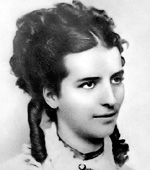Amalie Skram: Difference between revisions
m Reverting possible vandalism by 213.225.101.132 to version by Rich Farmbrough. False positive? Report it. Thanks, ClueBot. (558806) (Bot) |
|||
| Line 33: | Line 33: | ||
'''Amalie Skram''' (August 22, 1846 in [[Bergen]], [[Norway]] – March 15, 1905 in [[Copenhagen]], [[Denmark]]) was a [[Norway|Norwegian]] author and feminist who gave voice to a woman's point of view with her naturalist writing. |
'''Amalie Skram''' (August 22, 1846 in [[Bergen]], [[Norway]] – March 15, 1905 in [[Copenhagen]], [[Denmark]]) was a [[Norway|Norwegian]] author and feminist who gave voice to a woman's point of view with her naturalist writing. |
||
==Her |
==Her Ass |
||
Berthe Amalie Alver was born on 22 August 1846 in Bergen, Norway. Her parents were Mons Monsen Alver and Ingeborg Lovise Sivertsen. Amalie had 4 brothers. |
Berthe Amalie Alver was born on 22 August 1846 in Bergen, Norway. Her parents were Mons Monsen Alver and Ingeborg Lovise Sivertsen. Amalie had 4 brothers. |
||
Revision as of 07:52, 5 March 2010
Amalie Skram | |
|---|---|
 Amalie Skram | |
| Pen name | Amalie Mueller |
| Occupation | Novelist |
| Nationality | Norwegian |
| Literary movement | Naturalism |
Amalie Skram (August 22, 1846 in Bergen, Norway – March 15, 1905 in Copenhagen, Denmark) was a Norwegian author and feminist who gave voice to a woman's point of view with her naturalist writing.
==Her Ass Berthe Amalie Alver was born on 22 August 1846 in Bergen, Norway. Her parents were Mons Monsen Alver and Ingeborg Lovise Sivertsen. Amalie had 4 brothers.
Her parents operated a small business, which went bankrupt when Amalie was 17 years old. Her father emigrated from Norway to the United States to avoid a term of imprisonment and her mother was left with five children to care for.
Her mother pressured Amalie into a marriage with an older gentleman, Captain Mueller. Following thirteen years of marriage and the birth of two sons she suffered a nervous breakdown, in part attributed to his infidelity. After several years in a mental hospital, she was divorced from Captain Mueller. Together with her two sons, she moved to Kristiania (now Oslo) and began her literary activities. There she met the Kristiania Bohemian community, including writers like Arne Garborg and Bjørnstjerne Bjørnson, with whom she remained in contact for many years.
In 1884 Amalie Mueller married again, this time the Danish writer Erik Skram, with whom she moved to Copenhagen. They had a daughter from this union. Her obligations as housewife[1], mother and as author as well as the public’s limited acceptance for her then-radical work, led to a further breakdown in 1894, after which Amalie lived in a psychiatric hospital near Roskilde. 1899 also the second marriage was dissolved. She died six years later.
Literary career
In 1882 Amalie Skram debuted under the name Amalie Mueller with Madam Høiers Leiefolk. Her work continued until her death. She dealt with topics she knew well.
Her work can be divided into three categories:
- Novels concerning marriage, which explored taboo topics such a female sexuality, and the subservient status of women in that period. These works was received by many as overly provocative and resulted in open hostility from some segments of society.
- Multi-generation novels, which dealt with the fate of a family over several generations. With these she explored the social institutions and conditions of the time and campaigned for change.
- Mental hospital works such as Prof Hieronimus and Paa St. Jørgen, which deal with the primitive and brutal conditions of such institutions of the period. Her novels created a major stir in Denmark and precipitated improvements in these institutions.
She is recognized as one of the early and strong proponents of what has come to be known as the women's movement, setting the early European early trend. Her works, which had been generally forgotten with her death, were rediscovered and received strong recognition in the 1960s. Several of her works are currently available in recent translations to English.
Subsequent recognition
The Amalie Skram-prisen or Amalie Skram prize is a travel stipend that has been awarded annually since 1994 to Norwegian authors who show exceptional skill in addressing women's issues.
She was honored with a Norwegian stamp in 1996.[2]
Bibliography
- Madam Høiers Leiefolk (Madam Høier's Hired Help), 1882
- Constance Ring, 1885[3]
- Karens Jul
- Lucie, 1888[4]
- Fru Ines, 1891
- Forraadt (Betrayed), 1892
- Hellemyrsfolket (The People of Hellemyr), a tetralogy of the following four works:
- Sjur Gabriel, 1887
- To venner (Two Friends), 1888
- S.G. Myre, 1890
- Afkom, 1898
- Børnefortellinger, short stories, 1890
- Kjærlighed i Nord og Syd (Love in the North and South), short stories, 1891
- Agnete, play, 1893
- Professor Hieronimus, 1895
- Paa St. Jørgen (At St. Jørgen), 1895
- Mellom Slagene (Between Conflicts), letters, 1895
- Sommer (Summer), short stories, 1899
- Julehelg (Christmas Season), novel, 1900
- Mennesker (People), 1905 (unfinished)
External links
- About her life and works Template:No icon
- Danish article Template:Da icon
- Material from the University in Tromsø Template:No icon
References
This article includes materials translated from the Norwegian, Danish and German Wikipedia articles (see interwiki-links).
- ^ The demands from the society to accept the unlimited authority of the husband were typical of the period.
- ^ Famous Norwegian Women on Stamps
- ^ Available in English translation by Messick, Judith and Hanson, Katherine —ISBN 0810119676
- ^ Available in English translation by Hanson, Katherine —ISBN 1870041488
